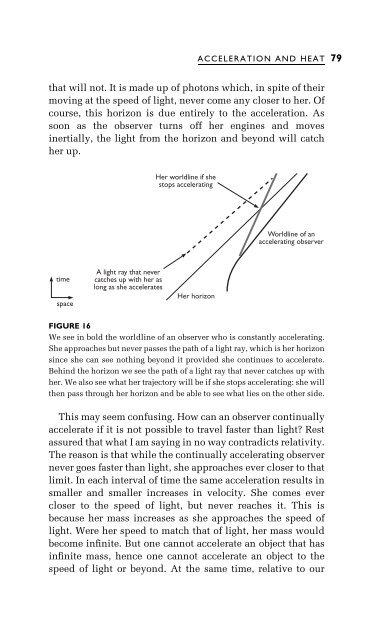Three Roads To Quantum Gravity
Three Roads To Quantum Gravity
Three Roads To Quantum Gravity
You also want an ePaper? Increase the reach of your titles
YUMPU automatically turns print PDFs into web optimized ePapers that Google loves.
ACCELERATION AND HEAT<br />
79<br />
that will not. It is made up of photons which, in spite of their<br />
moving at the speed of light, never come any closer to her. Of<br />
course, this horizon is due entirely to the acceleration. As<br />
soon as the observer turns off her engines and moves<br />
inertially, the light from the horizon and beyond will catch<br />
her up.<br />
Her worldline if she<br />
stops accelerating<br />
Worldline of an<br />
accelerating observer<br />
time<br />
space<br />
A light ray that never<br />
catches up with her as<br />
long as she accelerates<br />
Her horizon<br />
FIGURE 16<br />
We see in bold the worldline of an observer who is constantly accelerating.<br />
She approaches but never passes the path of a light ray, which is her horizon<br />
since she can see nothing beyond it provided she continues to accelerate.<br />
Behind the horizon we see the path of a light ray that never catches up with<br />
her. We also see what her trajectory will be if she stops accelerating: she will<br />
then pass through her horizon and be able to see what lies on the other side.<br />
This may seem confusing. How can an observer continually<br />
accelerate if it is not possible to travel faster than light? Rest<br />
assured that what I am saying in no way contradicts relativity.<br />
The reason is that while the continually accelerating observer<br />
never goes faster than light, she approaches ever closer to that<br />
limit. In each interval of time the same acceleration results in<br />
smaller and smaller increases in velocity. She comes ever<br />
closer to the speed of light, but never reaches it. This is<br />
because her mass increases as she approaches the speed of<br />
light. Were her speed to match that of light, her mass would<br />
become in®nite. But one cannot accelerate an object that has<br />
in®nite mass, hence one cannot accelerate an object to the<br />
speed of light or beyond. At the same time, relative to our



![arXiv:1001.0993v1 [hep-ph] 6 Jan 2010](https://img.yumpu.com/51282177/1/190x245/arxiv10010993v1-hep-ph-6-jan-2010.jpg?quality=85)


![arXiv:1008.3907v2 [astro-ph.CO] 1 Nov 2011](https://img.yumpu.com/48909562/1/190x245/arxiv10083907v2-astro-phco-1-nov-2011.jpg?quality=85)








![arXiv:1002.4928v1 [gr-qc] 26 Feb 2010](https://img.yumpu.com/41209516/1/190x245/arxiv10024928v1-gr-qc-26-feb-2010.jpg?quality=85)
![arXiv:1206.2653v1 [astro-ph.CO] 12 Jun 2012](https://img.yumpu.com/39510078/1/190x245/arxiv12062653v1-astro-phco-12-jun-2012.jpg?quality=85)
